
22 Nov’19
Welcome to the
I Don’t Know Club
Where scientia / science = knowing is a journey, a never-ending voyage
of discovery, learning, wondering, questioning..
Where admitting ignorance is an essential modus operandi
and foundational degree:
Professor Ignorans Stupend

(stupendously ignorant)
– At least as important as knowing is acknowledging what one doesn’t know. –
But where to start amidst seemingly endless seas of puzzling / confounding /
mind-boggling wonders?
How about an eyelash? → 
(Devilish minutiae
can cloak treasure troves.)
Is it not astounding how scores of these fibrillar appendages ever grow along eyelids, yet
ever remain a constant, elegantly coordinated chorus line defending and highlighting precious eyes?
Somewhat similar is this living fence:

click images for source
ever needing trimming to a constant height.
All ones eyelashes somehow remain perfectly coordinated in length, seemingly by themselves:
growing longest in the middle of each eyelid, then gradually shorter toward the ends of each lid.
Like removing soil to study roots, images below reveal a single hair follicle like those inside eyelids
ever growing each eyelash,* along with surrounding tissues and organelles, progressively more magnified:
*eyelashes are much more crowded together, of course
Discussion continues following these four eyelash-opening images:

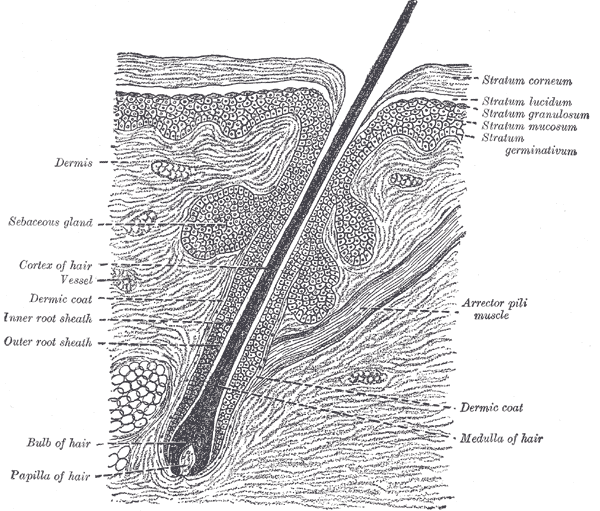
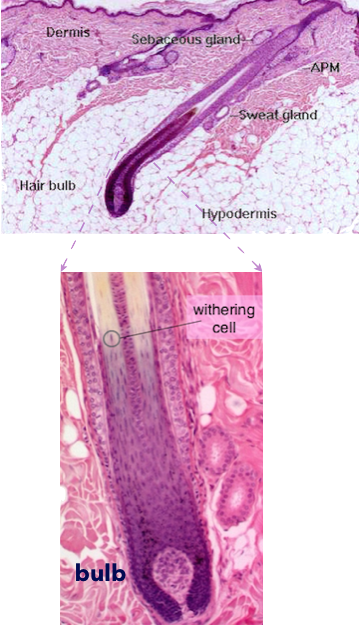
colors due to dyes
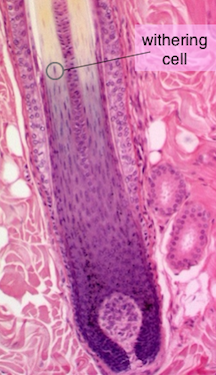
The “bulb” at the bottom of the above image is where each eyelash originates
as microscopic, egg-like cells ever duplicate themselves, then gradually dry out,
whither and die into a mummified, resilient, springy residue thus ever emerging
from its follicle nursery, as ever more cells are created in this growth region
somewhat resembling an underground flower bulb, ever replacing cells above them
gradually whithering and toughening into the hair shaft ever emerging at a glacial pace as
just ONE eyelash.
These images reveal each follicle is surrounded, supported and nourished
by numerous different tissues and tiny organs formed by countless more millions of cells
of hundreds if not thousands of types, including layers of skin cells surrounding each hair shaft,
plus glands secreting the oily lubricant called sebum coating and protecting the shaft and skin..
(plus other hairs (not lashes) have a muscle that makes each stand on end, called arrector pili':
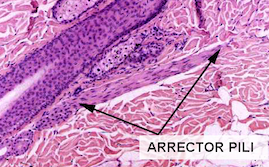 ).
).
The top image (also below↓) reveals the complex organelles and tissues forming each hair are surrounded,
immersed among numerous other structures, including organs of the senses of touch and warmth, plus
nerves, sweat glands, blood and lymph vessels, fat cells, supporting fibers and the cells that generate them.
Plus various layers and numerous types of skin cells separate all the living cells beneath
from the environment, where they would perish outside the body..
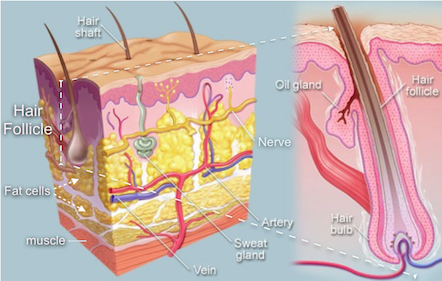
All these cells are continually bathed in nourishing, oxygen-rich fluids constantly leaking from blood,
then reabsorbed into lymph vessels and veins transporting waste products to kidneys
and other elimination routes for such worn-out, often toxic stuff.
No one knows exactly, of course, but just the lashes of one eyelid clearly require some hundreds of millions
if not billions of living cells of at least hundreds of types, each continually nourished and supported
in countless ways by all the other organs and systems of the body.
Somehow the growth of ones hundreds of eyelashes is coordinated perfectly, their different lengths
adjusted along the edge of each lid: longer in the middle, much shorter at each end of a lid:
Growth cycles must be timed perfectly, for each eyelash hair grows weeks to maturity,
then endures long enough until another is ready to replace it, whence the older one eventually falls away,
the timing staggered all along each eyelid so there are always plenty of mature lashes in place.
How a human body orchestrates millions of cells of at least hundreds of types
plus legions of life processes necessary to grow and maintain just one eyelash remains essentially
a mind-boggling, immense complexity full of unknowns, innumerable unanswered questions.
See below how DNA provides no such answers, as biologists tacitly acknowledge.
Perhaps most mind-boggling of all is how a single fertilized egg cell gives rise to the vast hoards of nearly
countless cell types, in dozens of organs and hundreds of tissues that become a fully formed newborn.
Here are greatly enlarged images of a human embryo growing from three to four weeks old,
from about as long as a grain of sand is wide to about a quarter inch long:



images hugely enlarged..
click here to reveal actual,
much greater size differences*
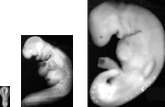
*scaling is approximate
click above again to hide
At left there are no organs. By the middle image just a few days later, numerous metropolises of cells
are differentiating and coordinating to become brain, heart, liver.. then nearly countless organs
are well under way just a few more days later in the far right image: In just weeks, one fertilized egg cell
grows into countless millions then billions of cells, of different types by the thousands.
Endless questions how such wonders of growth and development occur remain utterly unanswered:
how these galaxies of cells grow and coordinate with each other as they build myriads of tissues
perfectly arranged into many different organs, each organ formed as cells differentiate into countless types,
each type performing unique functions.
Following DNA discoveries more than half a century ago, these glaring unknowns were simply swept
under confident assertions how myriads of genes must direct and coordinate the
colossally complex processes transforming one germ cell into organs, limbs, a complete human being.
After an entire human genome was declared sequenced and found to contain only a couple dozen thousand
genes some years ago – hopelessly far too few to direct such vast numbers of unique and mind-bogglingly
complex processes: The silence remains deafening throughout the world’s biology departments,
unspoken tributes to how inexplicable life remains.
See below for many more details how the DNA “Central Dogma” holds no water.
Each cell itself becomes ever more discombobulating
as biologists continue discovering ever more functions and structures.
Below is a cutaway schematic of a single cell demonstrating a metropolis of a large variety
of internal compartments separated by layers upon layers of internal membranes plus tiny microtubules
endlessly dividing cells into regions focused on particular processes: tens of thousands ever occurring
at mind-boggling rates, making a beehive look virtually unpopulated and slothful in comparison:
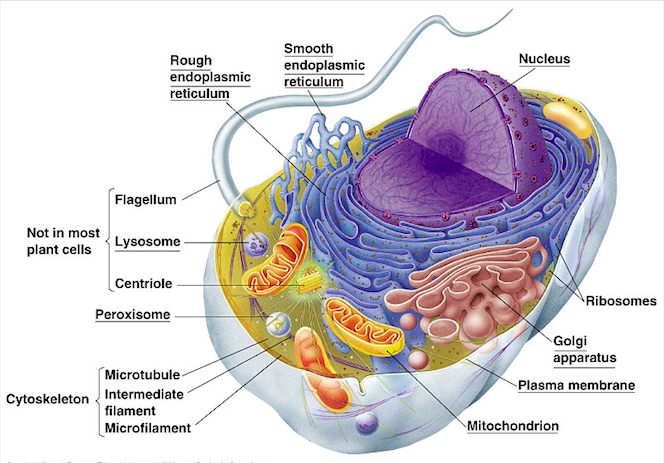
colors arbitrary, for contrast
Again, how all these endless complexities of structure, process, and function are coordinated
and integrated into each cell’s astoundingly persistent constancy remains essentially, vastly unknown.
Known genes almost entirely consist of codes for thousands of unique enzymes and related biochemicals,
hence provide essentially no clues how myriads of substances are directed and assembled into
the countless complexities of each single, living cell.
Not to mention how countless individual cells of scores to hundreds of types
are organized into a single, unique organ.
How biologists’s core claims regarding DNA hold no water
is examined in detail on this site’s Central Dogma page.
The Quest to Know
While some humans seem satisfied believing unseen beings and/or God(s)
ever direct and sustain living cells, tissues, and organisms:
Believing is a word used only when one does not know:
If one knows something, one says so, does not usually try to conceal knowing by saying one believes.
The word science derives from Latin words clearly referring to the process of knowing,
as distinct from believing, faith, religion, and such.
But how often do scientists and their proponents and supporters readily acknowledge
how precious little we humans know, much less understand?
A professor of science is paid to profess knowing, not ignorance.
Membership Motto:
Anyone is an active member of the I Don’t Know Club
who refuses to accept anything as true one doesn’t know for oneself.
who refuses to accept anything as true one doesn’t know for oneself.
Although certainly an uncommon, even unlikely path to wealth or fame,
some find significant to great satisfaction in truly knowing something.
In truth: Almost if not every human being is a member of the I Don’t Know Club, at least
to the incalculable extent we know so little, understand and comprehend so exceedingly little of existence
– Deny it however one will!
As Shakespeare put it so well:
Disclosure
This I Don’t Know Club site contains something to lots offensive to pretty much everyone.
Sacred cows* can distract the quest for truth, the drive to know and comprehend fully, among both
those who merely believe in such bovines, as well as hypocrites who deny unfounded worship of them:
Sadly, many who profess being a scientist are among the latter.
* – Not that cows are not wondrous, magnificent beings, deserving much admiration and respect,
as are pretty much every other aspect of the unimaginably vastly wondrous Earth and cosmos. —
This site expresses little-known methods the journey to master takes highly variable time.
Astronomical, Geological and Physics Unknowns
Although many think physicists better comprehend matter than biologists life, changing the final f sound
to t demonstrates the English language’s creators considered life and light closely related.
Close examination reveals mysteries physicists and astronomers commonly overlook, not just about light,
but also by far it’s most crucial source, the Sun, essential for life as we know it.
Several aspects of the Solar System and cosmos revealing glaring deficiencies in prevailing views
are discussed on this additional page, including links to prestigious sources, especially a NASA page
admitting mind-boggling phenomena the Sun demonstrates that physicists are utterly unable to explain.
Seismology Demonstrates Seismic Waves Are Confined
Within an Astoundingly Thin Outer Shell
What, then, is the deep interior of the Earth like?
This mind-boggling discovery is discussed in detail at What’s Inside Earth?
Then just how did Earth come to exist?
Is Kant-Laplace / Nebular Hypothesis now in history’s reject bin?
section hidden above:
These scaled* images indicate how incredibly rapidly human embryos grow, virtually mushroom in size.
(embryos are magnified multiple times actual size)
* scaling is approximate

3 3++ 4
weeks old